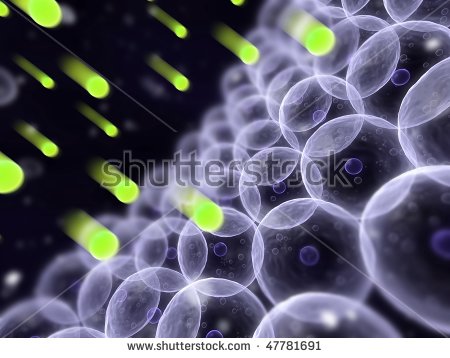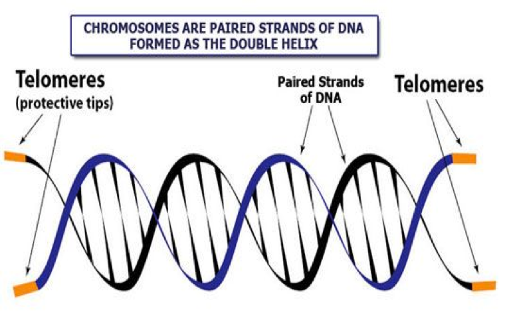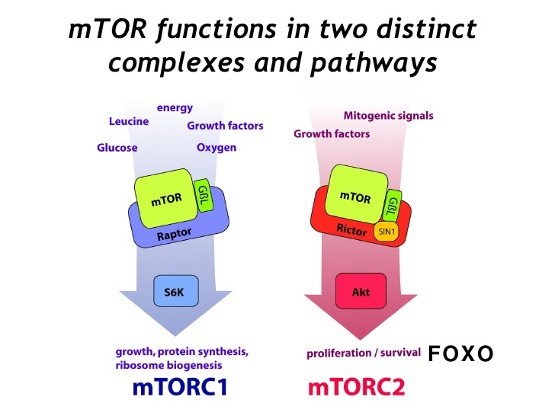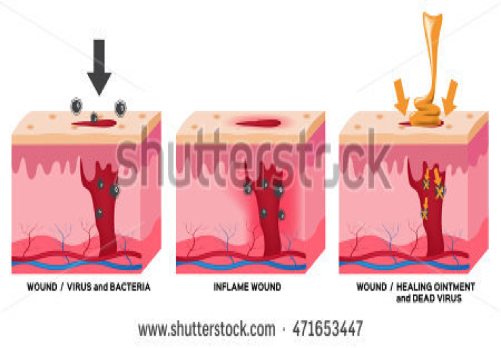Causes of aging
by Dr. Ashraf Girgis
Published: 04.03.2017
When we talk about research in aging, we can’t help but be skeptical these days. For good reasons, because one can find conflicting research results on the same subject. Although one can read the small details to confirm or reject the validity of the research, it is difficult to come to clear conclusions. So here I would like to discuss several scientifically proven reasons behind aging. These are 9 top reasons:
1. Free radicals
2. Telomerase
3. Genetics
4. Hormones
5. mTOR, a p
6. Environmental toxins
7. Food and Nutrients
8. Stress
9. Inflammation

1. Free radicals and oxidation
The free radical theory was first brought up by Dr. Grechman in 1954 and later by Dr. Dunham at the University of Nebraska and is currently the most accepted theory of aging. Free radicals form when an oxygen molecule is missing an extra electron and is searching for the missing particle and taking it from other molecules, leading to their oxidation. Oxidation causes cellular damage when it attacks cell membranes. Free radicals are blamed for age spots to wrinkles and many other age related issues. That is why using food with anti-oxidants or vitamins such as C, E, etc. are important, in minimizing oxidation. Aging itself has been associated with increased oxidative stress and lower antioxidant defenses (Bokov et al. 2004).

2.Telomerase
Telomeres are repetitive sites at the ends of chromosomes (we each have 46 chromosomes, 23 from father and 23 from our mothers). Each chromosome is like rows of books with a cap at each end called telomeres. Telomere shortening is associated with age-related diseases in humans. Telomeres protect the internal regions of chromosomes. Some cells can reverse telomere shortening by expressing an enzyme called telomerase. This enzyme extends the telomeres of chromosomes. The Nobel Prize in Physiology and Medicine in 2009 was awarded jointly to Elizabeth H. Blackburn, Carol W. Greider and Jack W. Szostak "for the discovery of how chromosomes are protected by telomeres and the enzyme telomerase. When there is lack of telomerase enzyme activity in humans, this seems to be accompanied by age related issues. Studies1 have shown a critical role for telomere length in the overall fitness, reserve, and well-being of the aging organism. Scientist liken telomeres to a cap at the end of a shoelace that holds the lace together.
Some vitamins and enzymes in food, herbs and spices, similar to stress management and exercise, seem to slow down telomere shortening, therefore slowing down the aging process.

3.Genetic
The role of genetics in aging has been well known. Centenarians who seem to be resistant to many age-related diseases have been studied and looked at. Scientists found out that for example, changes in certain genes can reduce the accumulation of DNA damage and slow the process of aging. A great example of this is variations in gene P66 which can protect cells from various age-related damage and diseases in animal studies. In Sicilian males, the likelihood of living to 100 years is associated with the presence of a certain gene (HLA DRB1*18 allele). Although the impact of genetics has been undeniable, some among scientists believe that our diet and life style can change the way our genes behave.

4. Hormones
There has been for many years a belief among many scientists that Growth Hormone (GH) can impact longevity. Although some studies have shown a link between GH use and cancer, many believe otherwise. Rudman and colleagues (1990) reported use of GH in males 66 and older with signs of deficiency for a period of 6 months resulted in increased muscle mass and bone mineral density in addition to improved over all well-being. Others like Liu and colleagues (2007) dispute these findings with studies of their own. However, over all use of GH demonstrated improvement of symptoms and even in some cases reversal of aging by use of GH in aging populations among those who seems to have deficiency. (Baum et al 1998; Shalet et al 2006; Arwert et al 2006).

5.mTOR
mTOR is a protein that regulates metabolism of the cell and its growth and survival through effects on stress, nutrients, hormones, and energy signals. mTOR directly or indirectly regulates critical processes of phosphorylation (introducing phosphate to a molecule group) of 800 different proteins. Most organism that have evolved have a pathway that allows them to survive and grow in various environment. Such a mechanism in mammals is referred to as mTOR. The mTOR pathway is a mechanism that is anchored by a protein kinase working as a signaling network.

6. Environmental toxins
There is no doubt any longer that environmental toxins, chemicals and pollutants can impact the physiological balance in our body, resulting in premature aging or causing diseases such as cancer, respiratory and cardiovascular disease, shortening of lifespan. Environmental pollutants and chemicals adversely influence the homeostatic status of aging, frequently resulting in development of certain diseases at an earlier age than expected. A study by Park et al. (2006) concluded “elderly men with metabolic syndrome were more susceptible to autonomic dysfunction in association with chronic lead exposure.” In another study, long term exposure to traffic pollutants in elderly men resulted in increased blood pressure, cardiovascular disease and stroke (Schwartz et al.2012). A study in Korea (Kim and Hong 2012) showed that exposure to air pollution resulted in elevated insulin resistance possibly leading to metabolic syndrome. In another study (Bae et al 2012), exposure to bisphenol (a product commonly found in bottled water and canned food and many other products) can result in lower heart rate and increase in blood pressure, especially in elderly populations, leading to cardiovascular diseases. These are just a few examples. We know how much of an important role the environment plays in developing cancer as well as many other diseases. Bae et al. (2012) reported that bisphenol A exposure was associated with increased blood pressure and decreased heart rate variability, suggesting that the elderly might be more susceptible to the possible cardiovascular effects of this ubiquitous endocrine-disrupting agent.

7. Food and Nutrients
We are all familiar with the relation of food to our health. We have heard the infamous words of “We are what we eat”. We do know that eating less animal fat and more vegetables and fruit is good for us for reducing heart disease and many other diseases. We also know the relationship between diet and cancer. A study of food restriction in individuals between 2-15 of years showed significant reduction in body weight, cholesterol, glucose and blood pressure. A number of clinical studies suggest diets high in calories and fat are associated with cardiovascular diseases, type 2 diabetes, dementia and other age related issues. Also, much evidence shows the effect of fat in cardiovascular diseases (trans fats, saturated animal fat, polyunsaturated fats). Other effects of nutrients like vitamin D and calcium in osteoporosis and bone fracture are well recognized. Basically, nutrients we eat have a direct effect on aging. Some scientists believe nutrients received in childhood and even in the fetus may influence the later development of aging diseases and lifespan.

8. Stress and aging
Stress and aging is possibly the most obvious of all causes. Because one can see it all around us. One of the examples I use when I give my talks is American presidents before their elections and after. If you compare president Bush and Obama’s pictures before and after, it is amazing how much they got aged during the 8 years of office. Or another example is those who lose their loved one unexpectedly, the changes is almost overnight. There is a statement by Hans Sylay the father of stress who famously stated “I have performed many autopsies; I have yet to see people dying of old age”. What he was implying is that stress causes much damage leading to death. Dr. Owen Wolkowitz and colleagues at University of California, San Francisco (UCSF) have associated stressful life experiences in young age with accelerated aging. A study published in September 2013 showed for the first time that stress management and lifestyle changes can result in longer telomeres. As mentioned above, longer telomeres means a longer lifespan.

9. Inflammation and aging,
More and more, scientists believe what causes aging has direct relation with chronic inflammation. Acute Inflammation is our body’s response to anything perceived as an invader and has a protective role against bacteria, viruses and allergens etc. However, if the body stays constantly in chronic inflammation, that is when symptoms of diseases seem to flare up and destroys our body’s homeostasis or balance, causing many diseases such as cardiovascular to cancer to arteritis etc. etc. You can read my article about auto-immune diseases here. Scientists also are convinced the reason for autoimmune disease is chronic inflammations. So, finding the cause of inflammation and taking steps to prevent inflammation is a way forward in increasing long life and preventing age-related diseases. It is important to know that food, nutrients and gut health play essential roles in preventing inflammation, as 65-80% of our immune mechanism is inside our guts and keeping the balance of the microbiome is essential in creating balance. Cleansing of the gut from cumulative toxins by nutrients rich in fibers combined with foods that can provide pro and pre-biotics is also important. You can read my article about probiotic and prebiotic here.
Thanks for visiting www.curenaturally.org for life style changes please make appointment with Dr. Girgis at 616-777-0608.
REFERENCES: